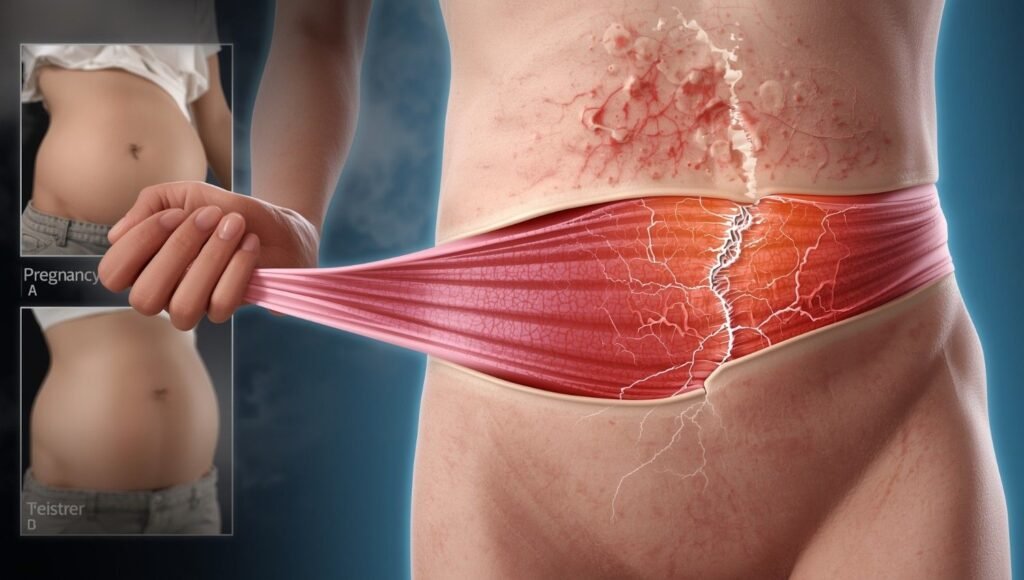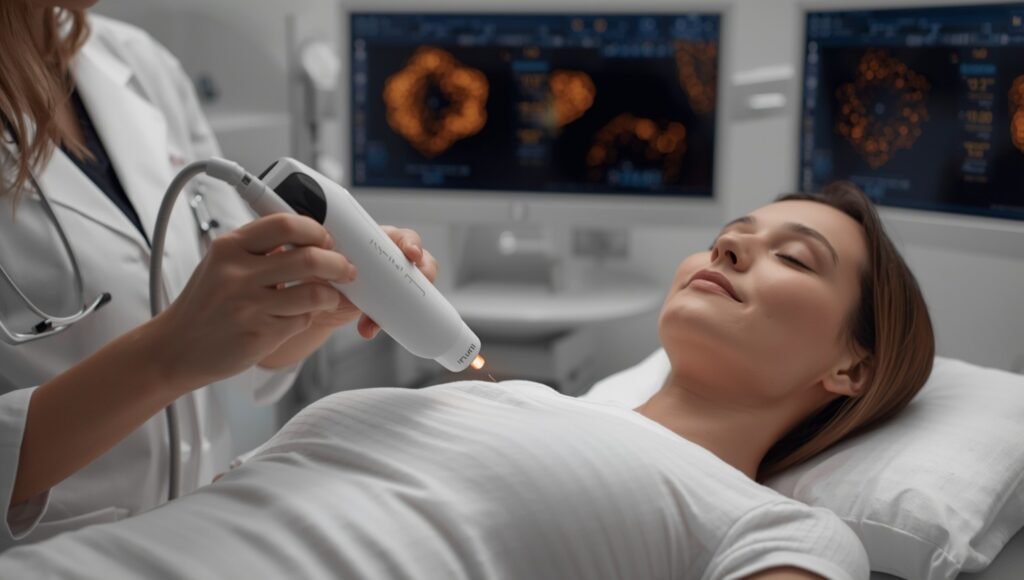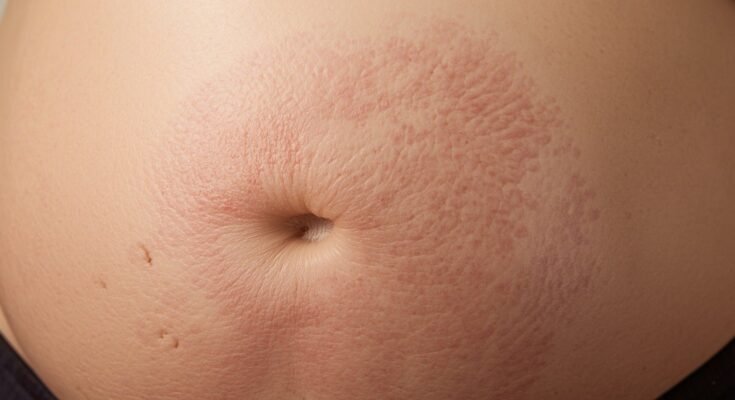A stretch mark is a type of scar that develops when our skin stretches or shrinks quickly.
Introduction
When the skin stretches or shrinks quickly, it can lead to an abrupt change inside the body. This sudden shift often causes collagen and elastin, which give the skin its support, to rupture. As the skin heals, a stretch mark develops and may appear as narrow bands. I remember noticing this during my teenage years when growth spurts in puberty combined with rapid weight gain from muscle training made my skin feel tight and sometimes itchy. For some people, fluctuating hormone levels during pregnancy or even long-term use of corticosteroid creams can also be a cause. Rare conditions like Cushing’s disease or Marfan syndrome can increase the risk, especially if your family has a history of these issues.
In my personal journey, I first saw them as red, purple, or pink marks, but over time, they faded into brown, dark brown, or reddish-brown streaks. Some felt slightly raised, and others seemed to sink beneath the skin, leaving what looked like a mature scar or mild depression. While this type of scarring is harmless, many—including myself—find the unsightly changes to be frustrating. That’s why I began exploring natural options, like making small diet changes, trying topical creams, and simple lifestyle modifications. With a little patience, you can reduce the appearance of these lines and feel less self-conscious. From experience, the best tips often come from trial and error, and there are at least eight effective ways to begin this journey if you want to eliminate them permanently or at least naturally manage them.

Are you looking for a natural way to reduce stretch marks?
Many people feel self-conscious about the appearance of their skin, and I was no different when I first noticed mine. I was so eager to try anything that could help me get rid of them. There are many options, and while it’s often hard to decide which ones are the best, I found that a mix of at least eight ways worked for me. When you start making changes the right way and stick with them, away from old habits, you can see results almost permanently. Some of the naturally helpful approaches include following simple tips like focusing on your diet, introducing healthy changes, using topical creams, and making small lifestyle modifications.
By combining these strategies, it’s possible to eliminate the unsightly lines and feel more comfortable in your own skin. The key is not rushing—improvement comes step by step, but even small efforts can reduce stretch marks in ways that make you feel more confident.
What can get rid of stretch marks?
A scar, such as a stretch mark, may not be permanent, but the right treatment can make it less noticeable and even alleviate the itch. It’s important to understand that no single method works for everyone, and not all products help. Over the years, researchers have discovered different treatments, and in medical terminology, these marks are called striae. They are a type of scarring caused by skin stretching rapidly due to changes in the body, whether in shape or size. Common triggers include growth, pregnancy, extreme weight gain or loss, or even bodybuilding.
Although some see them as an aesthetic flaw, they are a normal response of the skin and cannot be completely erased. Still, there are many ways to reduce their appearance and prevent further marks from appearing. Using topical creams and moisturizers with active ingredients like retinoids can promote collagen production. You can also try avoiding prolonged sun exposure, which worsens them. These steps may help diminish the visual signs, making both existing marks lighter and forming ones less severe.
Causes
Stretch marks are a common issue, and the main cause is when the skin and its tissue become stretched in a short period of time. This can happen because of sudden growth, weight gain, or hormonal imbalances during pregnancy. Factors like high cortisol levels from stress, bodybuilding, or even a genetic predisposition can also contribute. I noticed this myself as a teenager during a big growth spurt, when my body seemed to change overnight. The underlying collagen and elastin fibres can tear, especially if glucocorticoids from the adrenal glands become elevated, and that’s when marks show up.
While these marks are natural, they can look ugly or be a trigger for people who were once obese and later lost weight. Some even confuse them with cellulite, which is caused by fibrous bands pulling down on the fat under the skin. From my own perspective, learning to reduce their appearance made me feel I had taken the first step toward a smoother look. Even if you can’t fully get rid of them, understanding what causes them helps you decide how to manage or treat them—even the stubborn stretch marks.
Stretch marks commonly appear on the:
- Stomach
- Chest
- Hips
- Bottom
- Thighs.
How can you prevent stretch marks?
1-Stay hydrated
Keeping your skin hydrated by regularly drinking water is one of the easiest habits. Well-moisturized skin stays soft, which lowers the visibility of marks by reducing how prone it is to developing them. I found my marks got worse whenever my skin became dry, so staying consistent with water intake really helped.
2-Eat a healthy and balanced diet
A healthy, balanced diet full of nutrients is important. Vitamin A supports the development of new skin cells, while vitamin C helps the body produce collagen. Vitamin E works with C to create even better results, and zinc can cut down inflammation and speed up repair. I personally noticed faster healing when I improved my food choices, showing me how diet is key in prevention.
3-Talk to a skin specialist
If you are pregnant, or trying to lose or gain weight, seeing a skin specialist can give you a preventative plan. I was advised to reduce future risk after post-pregnancy changes by using creams and quality products that kept my skin supple and soft, while also improving my diet. Their guidance gave me a clearer direction rather than guessing what might work.
How do you treat stretch marks?
When you first develop stretch marks, it’s best to treat them straight away. If left alone, they may get worse, become harder to manage, and much more stubborn to deal with later. I learned that removing them isn’t about miracles—it’s about quickly acting with the right methods before they set deep into the skin.
1-Use a topical cream
The cosmetic market is full of creams and serums targeting stretch marks, but finding the right product can feel overwhelming. I tested several before finding the best ones, often ranked by price and efficacy. Some popular options include Palmer’s Cocoa Butter Formula lotion, which boosts collagen production and keeps the skin moisturized well. The company even suggests early use for maximum results. Others like Bepanthen Scar Treatment help smooth, soften, and flatten scars, and I liked the unique massaging device it comes with, easily available at the chemist.
For luxury, La Mer The Concentrate serum uses its Miracle Broth, made from sea kelp and other pure ingredients, to promote cell renewal and aid in skin formation. Although costly, I noticed it gave my skin a real boost. These creams don’t erase marks instantly, but consistent use really does help.
2-Dermatological treatments
If topical creams don’t give the desired appearance improvements, a dermatologist can recommend a wider range of dermatological treatments for the body. From my experience, professional advice made the difference when home remedies weren’t enough.
3-RF INFINI microneedling treatment
A minimally invasive procedure, RF INFINI uses a handheld device with tiny microneedles that are pressed against the skin. It delivers radiofrequency energy beneath the surface to multiply and repair deeper layers. This mix of microneedling and RF helps stimulate collagen, which is the most natural way for skin to recover.
The process feels gentler than more aggressive options, and it works to tighten skin and improve texture. Usually, you need five treatments, carefully spaced over several weeks. I found it helpful because the results came gradually and felt more lasting.
4-Fractional laser treatment
The Fraxel laser is a non-invasive, microscopic fractional tool that works directly on the skin to encourage collagen growth. Using a specific wavelength, it helps with rejuvenation, smoothing out wrinkles, remodelling scars, and even treating acne scarring.
Over time, it can rebuild new cells and reduce the appearance of older scars. I needed a few sessions before I saw visible effects, but it was worth it. These treatments, when properly spaced over several weeks, made my skin healthier and gave me confidence.
Do laser treatments hurt?

The experience varies person to person, but most stretch mark treatments with lasers are minimally or non-invasive. They’re designed to be gentler than more intense laser services I’ve tried before. The INFINI device, for example, was created after years of research into the optimum delivery of radio frequency energy. With its patented flow needling technology, it’s built to maximise comfort for patients while still being effective.
Some people may notice redness once the treatment is finished, but this often depends on your skin type. In my case, recovery was surprisingly short, sometimes just a single day. Knowing this gave me confidence to keep going with sessions without fear of long downtime.
Who can get laser stretch mark removal?
Almost any person, regardless of age, qualifies for laser removal treatments. The only dependencies are if you have preexisting skin conditions that might interact with the procedure. My dermatologist cleared me quickly, which shows it’s generally safe for most people.
How does it work?
Before starting treatments, a skin consultation is always performed. The doctor reviews your unique concerns, medical history, and any lifestyle or dietary factors that may affect results. A detailed analysis with advanced medical-grade technology—often under an ultraviolet lamp—helps dermal clinicians identify common problems before designing your plan.
Common skin problems
Hydration, oily flow, bacteria, overall health, and function are the main factors checked during this stage. These details guide the most effective treatment strategy.
8 Home remedies to get rid of stretch marks

1- Black tea
I’ve often enjoyed black tea not only as a healthy beverage but also for its surprising benefits. Its caffeine gives me an energy boost, supports metabolism, and can help with weight loss. Packed with antioxidants, it reduces oxidative stress in the body and even helps protect against certain medical conditions like colds or cancer.
Applied topically, black tea can combat marks by rubbing bags directly onto the skin. I like drinking a cup—either iced or hot—with friends in the afternoon, which makes it a relaxing ritual. It’s an incredible health habit that works from the inside and outside.
2- Olive oil
Olive oil has amazing health benefits and is one of my favorite remedies to get rid of marks. Known as a versatile gift used across cultures, it serves as both a natural medicine and a source of antioxidants, fatty acids, and nutrients that heal skin and improve its appearance.
It boosts elasticity, improves tone, and helps in preventing future stretch marks. Used as a lubricant and applied topically, it’s been trusted for centuries as a safe and effective solution.
3- Potato juice
Potato juice has become popular in the health and beauty space, often shared by gurus for its skin benefits. It’s a natural remedy for puffiness and marks, supporting the body by nourishing it with lemon, honey, and other nutrient blends.
This liquid can improve tone, brighten complexion, and be ingested or applied externally. I use it in my skincare routine, and it always feels refreshing.
4- Argan oil
Argan oil is a powerhouse in skincare thanks to its benefits. With rich fatty acids, antioxidants, and vitamins, it can moisturize, reduce inflammation, and fade discolorations.
I also love it as a conditioner for my hair, helping the roots to nourish and protect. This versatile oil gives dramatic results and has become a staple in many regimes for its truly versatile uses.
5- Coconut oil
Coconut oil is incredibly versatile and beneficial. Beyond being a kitchen ingredient for cooking, it’s a trusted remedy for skin and hair. With its moisturizing, hydrating effects, it softens dry areas, improves the appearance of marks, and even helps with psoriasis or eczema.
For hair, it reduces dandruff, adds shine to dull locks, and doubles as a makeup remover. I always choose cold-pressed organic coconut oil because it avoids harsh chemicals.
6- Aloe Vera
Aloe vera is a medicinal plant known since ancient times. Its leaves store a gel rich in nutrients and enzymes, bringing great health benefits. It soothes irritations, boosts collagen production, and works as a remedy for marks.
It also reduces inflammation, lightens pigmentation, and helps with smoothing and toning for a youthful glow. With continued use, it can heal damaged or irritated skin beautifully.
7- Sugar
Sugar is in our cereal and coffee, giving quick energy and flavor, but it also carries health risks like weight gain and high blood levels. Too much reduces collagen production, which weakens skin.
I learned the importance of moderation, since overconsumption makes it worse. Still, sugar scrubs can be great treats when used carefully, though daily consumption should be avoided.
8- Lemon Juice
Lemon juice is a simple remedy I often use. It’s an astringent that tightens pores, reduces oily skin, and keeps it firm and toned. Its citric acid helps to lighten spots and heal scars.
This makes it an effective treatment for marks, breaking down collagen fibers in the epidermis. It’s a natural fix for those unwelcome streaks.
Stretch mark creams, lotions, and gels
Creams, lotions, and gels are widely used to treat marks. I found that using the right product early can fade both early and mature marks. Regular massage makes them work more gently and effectively.
Consistency matters: you must apply daily for weeks before results appear. I’ve read how researchers studied these remedies and found some clever hacks to make them better.
Home remedies
According to studies, many remedies like almond oil, cocoa butter, olive oil, or vitamin E didn’t work. Some people massaged them in, but the marks never really faded. From what researchers saw, none worked consistently.
1-Self-tanner
A self-tanner can help with tanning, but it can also make marks more noticeable. At best, it camouflages early or mature marks, but it doesn’t actually rid you of them.
2-Prescription medicine you apply to your skin
Using prescription medicine on the skin can help. Ingredients like hyaluronic acid and tretinoin (a retinoid) in cream form made my marks less noticeable after several weeks. Retinol also helps to fade them over time.
In one study, people reported real relief when they applied these products daily, though early marks respond better than old ones. If left untreated, they can still grow.
3-Procedures that dermatologists perform
Dermatologists can offer different procedures such as chemical peel, laser therapy, microdermabrasion, radiofrequency, or ultrasound. Sometimes, they combine methods like a pulse dye laser for better results.
These can cause mild redness or swelling, but side effects are temporary and usually minor in the skilled hands of a board-certified doctor. For me, these treatments gave long-term results that improved my health and confidence, no matter my age.
Can anything prevent stretch marks?
While some say you can prevent them, many remedies like almond oil, cocoa butter, olive oil, or vitamin E don’t work. However, centella herb or hyaluronic acid in products has been discovered by researchers to sometimes work better.
When to seek a dermatologist’s expertise
A dermatologist’s expertise can help if home options fail. These treatments can be expensive, especially when buying from a store or online, but they often save money and time in the long run.
In-office procedures are usually more effective than any product. Speaking with a board-certified dermatologist gave me new, helpful options that worked better than trial and error.

Conclusion
There are many natural ways to get rid of marks. I’ve tried different combinations of remedies, and while no single method works for everyone, being patient and consistent made my results noticeable.
Change won’t happen overnight, but staying hydrated, eating healthy foods, and making time for exercise regularly improved my skin’s appearance and overall health.
Frequently Asked Questions
1-How can I permanently get rid of stretch marks?
Stretch marks are a natural part of life and affect many people regardless of age. Unfortunately, there is no guaranteed way to remove them permanently. However, several treatments can reduce their visibility and make them less noticeable. One of the most effective options is laser therapy, which uses a low-intensity laser beam to penetrate the skin’s dermis and stimulate collagen production. Collagen helps smooth out the lines and improve the overall appearance of stretch marks.
2-What is the fastest way to get rid of stretch marks naturally?
Stretch marks often occur due to rapid growth or sudden weight gain that stretches the skin beyond its limits. While they can’t always be avoided, there are several natural remedies that may help reduce them:
- Vitamin E oil – Promotes skin repair and regeneration, helping stretch marks fade over time.
- Aloe vera gel – Contains healing and moisturizing compounds that support collagen production and skin repair.
- Massage with natural oils – Almond, coconut, or olive oil can improve circulation, reduce inflammation, and encourage healing.
- Sugar scrub – Acts as a natural exfoliant, removing dead skin cells and promoting new tissue growth.
3-How can I lighten my stretch marks quickly?
Although removing stretch marks completely is difficult, certain treatments can help lighten them and improve skin texture:
- Laser therapy – Stimulates collagen production and skin regeneration, though multiple sessions may be needed, and costs can be high.
- Microdermabrasion – A more affordable procedure that exfoliates the skin, boosts collagen, and can show results after just one session.
- Topical treatments – Creams or lotions with retinoids, hyaluronic acid, or vitamin C can enhance collagen production, reduce inflammation, and improve skin tone.
For the best results, combine these treatments with healthy lifestyle habits such as staying hydrated, eating nutrient-rich foods like fruits and vegetables, and avoiding processed foods to keep your skin healthy and resilient.




